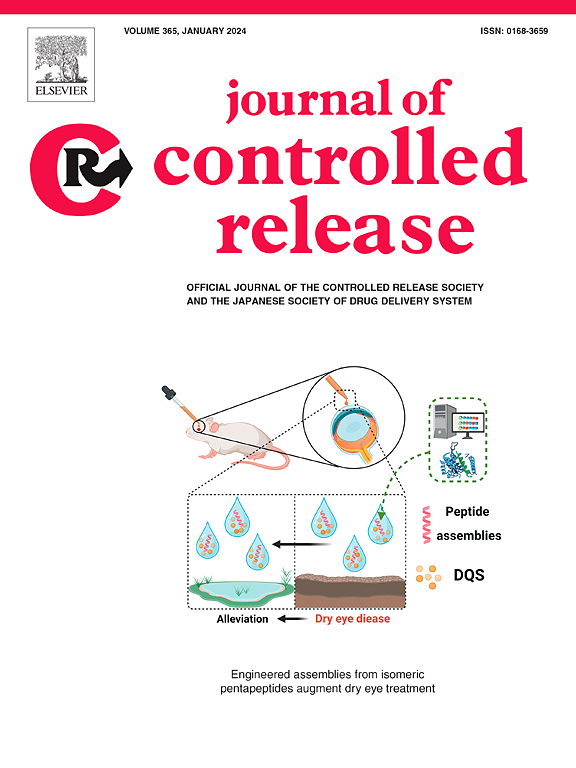Broadly active intranasal influenza vaccine with a nanocomplex particulate adjuvant targeting mast cells and toll-like receptor 9
IF 10.5
1区 医学
Q1 CHEMISTRY, MULTIDISCIPLINARY
引用次数: 0
Abstract
Flumist is the only FDA-approved intranasal influenza vaccine. Although it has recently been approved for at-home use, it has significant limitations. These include reduced effectiveness in generating a protective immune response in patients with extensive influenza exposure, safety concerns due to its live attenuated virus formulation, and reduced efficacy due to viral drift/shift. To address this limitation, we have developed a nanocomplex comprised of a mast cell (MC) agonist and toll-like receptor 9 (TLR9) ligand to adjuvant a broadly acting influenza antigen. The newly reported MC agonist was identified by screening mastoparan-7 analogs for MC degranulation activity, which led to a more active peptide analog, MP12W. Positively charged MP12W spontaneously forms nanoparticulate complexes (NPs) with CpG 1826 that were then used to intranasally vaccinate mice with a computationally optimized broadly reactive antigen (COBRA) hemagglutinin (HA) protein. The NPs were further optimized by substituting CpG 1826 with CpG 55.2, a TLR-9 agonist identified by machine learning to be more active in humans. MP12W-CpG 1826 NPs showed an increased pro-inflammatory response and decreased cytotoxicity in vitro compared to M7 complexes, translating into a safer profile in a model of increased hypersensitivity, collaborative cross mice 027 (CC027). Intranasal vaccination with this complex and broadly reactive HA resulted in higher mucosal antibody concentration and increased cytokine production with antigen recall. These responses were enhanced with MP12W-CpG 55.2 NP vaccination. MP12W-CpG NPs provided similar protection in an influenza challenge model. This study demonstrates the potential of this novel intranasal nanocomplex for vaccination.

具有广泛活性的鼻内流感疫苗,其纳米复合颗粒佐剂靶向肥大细胞和toll样受体9
Flumist是唯一获得fda批准的鼻内流感疫苗。虽然它最近被批准用于家庭使用,但它有很大的局限性。其中包括在广泛接触流感的患者中产生保护性免疫反应的有效性降低,由于其减毒活病毒制剂而引起的安全性问题,以及由于病毒漂移/转移而导致的有效性降低。为了解决这一局限性,我们开发了一种由肥大细胞(MC)激动剂和toll样受体9 (TLR9)配体组成的纳米复合物,以佐剂广泛作用的流感抗原。新报道的MC激动剂是通过筛选mastoparan-7类似物的MC脱颗粒活性来确定的,这导致了更活跃的肽类似物MP12W。带正电荷的MP12W自发地与CpG 1826形成纳米颗粒复合物(NPs),然后用计算优化的宽反应性抗原(COBRA)血凝素(HA)蛋白用于鼻内接种小鼠。通过用CpG 55.2取代CpG 1826进一步优化NPs, CpG 55.2是一种通过机器学习鉴定的TLR-9激动剂,在人类中更活跃。与M7复合物相比,MP12W-CpG 1826 NPs在体外显示出增强的促炎反应和降低的细胞毒性,这在高敏感性合作杂交小鼠027 (CC027)模型中转化为更安全的特性。鼻内接种这种复杂和广泛反应性的透明质酸导致更高的粘膜抗体浓度和抗原召回增加细胞因子的产生。这些反应在MP12W-CpG 55.2 NP接种后得到增强。MP12W-CpG NPs在流感攻击模型中提供了类似的保护。这项研究证明了这种新型鼻内纳米复合物用于疫苗接种的潜力。
本文章由计算机程序翻译,如有差异,请以英文原文为准。
求助全文
约1分钟内获得全文
求助全文
来源期刊

Journal of Controlled Release
医学-化学综合
CiteScore
18.50
自引率
5.60%
发文量
700
审稿时长
39 days
期刊介绍:
The Journal of Controlled Release (JCR) proudly serves as the Official Journal of the Controlled Release Society and the Japan Society of Drug Delivery System.
Dedicated to the broad field of delivery science and technology, JCR publishes high-quality research articles covering drug delivery systems and all facets of formulations. This includes the physicochemical and biological properties of drugs, design and characterization of dosage forms, release mechanisms, in vivo testing, and formulation research and development across pharmaceutical, diagnostic, agricultural, environmental, cosmetic, and food industries.
Priority is given to manuscripts that contribute to the fundamental understanding of principles or demonstrate the advantages of novel technologies in terms of safety and efficacy over current clinical standards. JCR strives to be a leading platform for advancements in delivery science and technology.
 求助内容:
求助内容: 应助结果提醒方式:
应助结果提醒方式:


